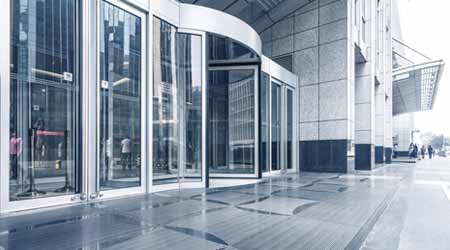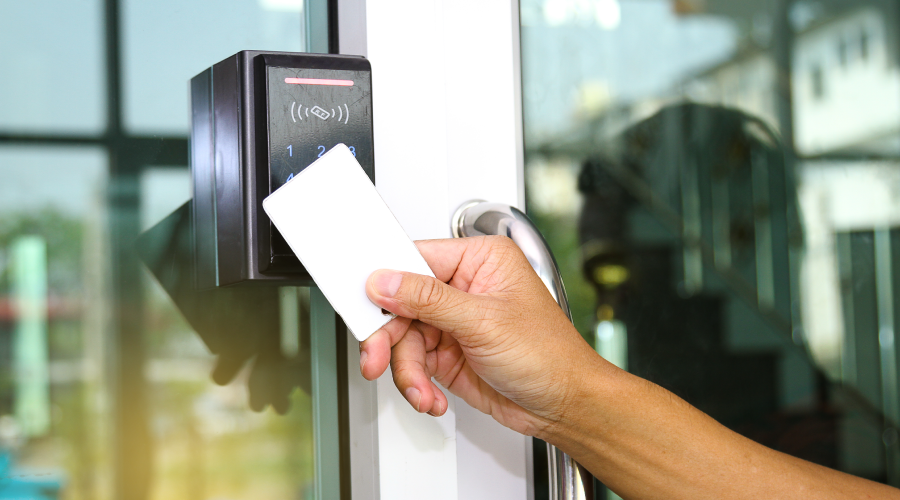 Facility managers should identify requirements for factors like durability and aesthetics based on the conditions in which the door and hardware will operate.
Facility managers should identify requirements for factors like durability and aesthetics based on the conditions in which the door and hardware will operate.How To Do Needs Assessment For Door and Door Hardware Selection
Factors to consider to make the proper door and door hardware selection include the impact of the environment, security, life-safety, emergency egress, and more.
It is critical that facility managers make certain that the right type of door and hardware are installed for each application. What is required is a needs assessment that takes into consideration where the door is being installed and the level of use that it will be exposed to. For example, doors that serve as main entrances to facilities will receive a higher level of use than those that are primarily emergency exits. Similarly, doors in educational facilities, such as middle schools and high schools will be subjected to a much higher level of use and abuse than those installed in a typical office building. Choosing the wrong type may save on first costs, but, once again, it will be more expensive to maintain.
Door hardware selection must also take into consideration factors related to the particular application. One common mistake is to use undersized hardware in high-use areas or in applications where a heavy door is installed. Both require a heavier duty set of hardware, typically a Grade 1 selection. Undersizing the hardware will result in long term maintenance problems, such as door misalignment and difficult operation, both of which can result is compromised security.
The impact of the environment must also be taken into consideration. Doors that are routinely exposed to moisture or high levels of humidity must have finishes and hardware that are highly resistant to corrosion if they are to last more than just a few years. Corrosion of hinges and other hardware can make doors stick and difficult to operate, hindering egress or compromising security.
The needs assessment must also consider the factors that will affect how the door will function in that application. These factors typically include life-safety, emergency egress, loss prevention, and security. While most will apply to some extent in all applications, they will not apply equally. Different types of hardware provide different levels of support for different functions.
Door health check-up
Even when the proper type of door and hardware is installed for an application, there still will be maintenance requirements. The tasks to be performed and their frequency is determined by the level of use that the door is subjected to, the environment in which it operates, and the desired level of performance needed. At a minimum, all doors should be checked twice each year. Doors subject to high use or abuse will require more frequent checks. The goal of the inspections is to identify issues that would interfere with the operation of the door, and to correct them before they develop into issues that would cause more problems with the smooth operation of the door or become costly.
Start with an examination of the finish on the door, its frame, and all associated hardware. Check for physical damage to all components. Is the damage cosmetic or is it sufficient to interfere with the operation of the door? Inspect for surface rust on all metal components or rot on wood doors and frames. Does the corrosion or rot penetrate the components or is it confined to the surface? Is repair possible or is replacement required?
Next, check the operation of the door. Does the door swing freely or does it bind? Does it fully close and latch? Measure the gap between the door and its frame. Is it consistent or does it vary? An inconsistent gap is an indication of the door sagging from loose hinges, or a frame that is out of square. Loose hinge screws can be tightened or replaced, but a frame that is out of square will require more extensive repairs. Both are issues that will only grow worse with time, resulting in increased binding.
One of the most common issues with doors is missing or damaged weatherstripping. Weatherstripping wears with normal use and is easily damaged by improperly aligned doors. Inspect all weatherstripping for damage and proper attachment. Damaged or missing sections should be replaced to help limit air infiltration between the door and the frame and sill plate.
Test all hardware installed on the door, particularly the closers. Door closers should be adjusted to allow the door to close and latch without slamming. Inspect the strike plate for damage and proper attachment.
Related Topics:














